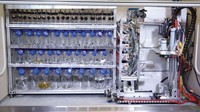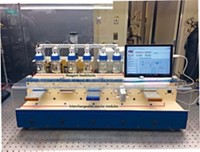Advertisement
Grab your lab coat. Let's get started
Welcome!
Welcome!
Create an account below to get 6 C&EN articles per month, receive newsletters and more - all free.
It seems this is your first time logging in online. Please enter the following information to continue.
As an ACS member you automatically get access to this site. All we need is few more details to create your reading experience.
Not you? Sign in with a different account.
Not you? Sign in with a different account.
ERROR 1
ERROR 1
ERROR 2
ERROR 2
ERROR 2
ERROR 2
ERROR 2
Password and Confirm password must match.
If you have an ACS member number, please enter it here so we can link this account to your membership. (optional)
ERROR 2
ACS values your privacy. By submitting your information, you are gaining access to C&EN and subscribing to our weekly newsletter. We use the information you provide to make your reading experience better, and we will never sell your data to third party members.
Pharmaceuticals
Flow process streamlines assembly of essential antibiotic
ACS meeting news: System makes ciprofloxacin salt in nine minutes without pausing to purify individual synthesis steps
by Tien Nguyen
August 24, 2017
| A version of this story appeared in
Volume 95, Issue 34

Flow chemistry—in which reagents course through a series of reactors to form new compounds—allows chemists to build molecules in a fast and efficient assembly-line-like way. But with each additional step, the reaction becomes more challenging: Solubility issues with intermediate compounds arise, and unwanted by-products can clog the reactor tubing.

Researchers have now overcome some of these limitations to engineer a flow process for making ciprofloxacin, an essential antibiotic. The overall reaction consists of six telescoped steps followed by a filtration and crystallization step to yield a ciprofloxacin hydrochloride salt. Telescoped steps are those in which the flow isn’t paused for offline purifications. According to the team, this is the longest linear sequence of telescoped flow steps so far achieved (Angew. Chem. Int. Ed. 2017, DOI: 10.1002/anie.201703812).
The flow sequence takes nine minutes. Batch chemistry, a more traditional process that produces molecules in discrete amounts, rarely generates product molecules within minutes, according to Timothy Jamison, whose group developed the new ciprofloxacin process in collaboration with Klavs Jensen’s lab at Massachusetts Institute of Technology. A current patented batch process for making ciprofloxacin takes more than 100 hours and has a comparable overall yield around 60%.
Hongkun Lin, a postdoctoral researcher in the Jensen lab, disclosed the synthesis earlier this week during a Division of Organic Chemistry poster session at the ACS national meeting in Washington, D.C.
The method “illustrates how to overcome many of flow chemistry’s problems,” said Christopher Smith, an organic chemist now at the University of Reading who formerly conducted work in the Jensen lab as a postdoc. For instance, the team addressed the low solubility of multiple intermediate reaction steps by screening multiple solvent systems and engineering the system to heat up to 180 °C then rapidly cool back to room temperature.
The team also sidelined an amine by-product in one step that would have interfered with a subsequent step by introducing acyl chloride. The compound reacted with the excess by-product to keep it from impeding the process, a very “clever” move, said Eindhoven University of Technology’s Timothy Noël, who is an associate editor of the Journal of Flow Chemistry.
The authors told C&EN that early efforts to scale up their process have yielded promising results.





Join the conversation
Contact the reporter
Submit a Letter to the Editor for publication
Engage with us on Twitter